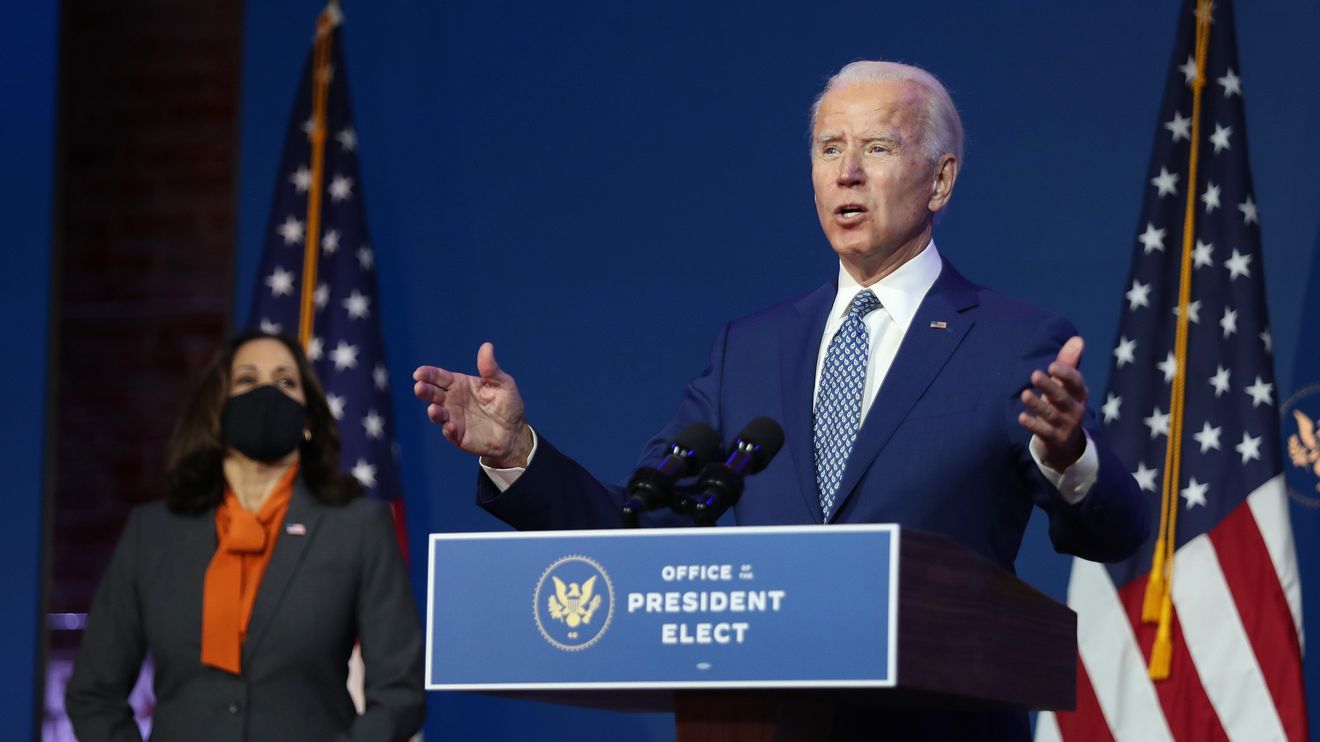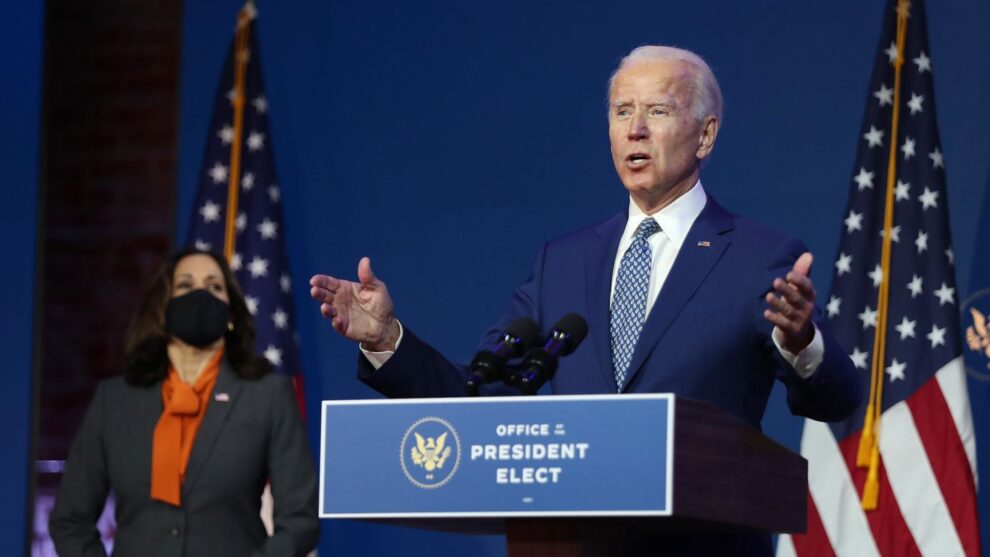
President-elect Joe Biden promised to raise the federal minimum wage to $15 an hour. It has been $7.25 an hour since 2009.
Joe Raedle/Getty Images
Florida, a state which President-elect Joe Biden did not win, voted in favor of achieving one of his campaign promises to raise its state minimum wage to $15 an hour from $8.56 by 2026. But when it comes to raising the federal minimum wage to $15 an hour, Biden is likely to encounter more hurdles.
Even before the pandemic, in Biden’s first official campaign speech, he promised to raise the federal minimum wage to $15 an hour if elected president. The federal minimum wage has been $7.25 an hour since 2009, which comes out to roughly $15,000 a year for someone working 40 hours a week.
Like Flordia, California, Connecticut, Illinois, Maryland, Massachusetts, New Jersey and New York all pledged to pay workers a minimum wage of $15 in the coming years. Other states have opposed efforts to raise their states’ minimum wage, fearing that implementing it could result in widespread job losses.
Currently, no state has an effective $15 minimum wage, but Washington D.C. does. Washington (state) and Massachusetts have the highest state minimum wages as of July 2020 at $13.50 an hour and $12.75 an hour, respectively, according to the Department of Labor.
Democratic lawmakers were hopeful that a “blue wave” would prevail in the House and the Senate for the upcoming year. That would make it much more feasible for Biden to enact a $15 federal minimum wage, among other policy changes he campaigned on.
It’s likely that Democrats will maintain control of the House, but majority control of the Senate could remain in the hands of Republicans. That’s if two incumbent Republican Senators in Georgia, Kelly Loeffler and David Perdue, win their runoff Senate elections that take place on Jan 5.
In which case, Senate Majority Leader Mitch McConnell would continue to be the gatekeeper of what is brought to the Senate floor to be voted on.
But even with uncertainty in the Senate, “there is no path to having a filibuster-proof majority in the Senate” to increase the federal minimum wage, said Heidi Shierholz, an economist at the Economic Policy Institute, a left-leaning think-tank based in Washington, D.C.
However, Biden could very well increase the minimum wage for workers on federal contracts through an executive order, she added.
Related: Here’s what Biden could change just by executive order
McConnell has refused to allow senators to vote on measures to raise the federal minimum wage
Last July, House Democrats passed the Raise the Wage Act, a bill that would increase the federal minimum wage to $15 an hour. McConnell refused to take up the matter in the Senate citing research from the Congressional Budget Office, a nonpartisan branch of government, found that raising the wage to $15 an hour by 2025 could cause 1.3 million workers to become unemployed as a result, according to the CBO’s median estimate.
“We don’t need to lose jobs. We don’t have enough jobs now,” McConnell said in a July interview last year. The unemployment rate in July 2019 hovered at 3.7%.
On the flip side, the CBO report found it “would boost the wages of 17 million workers who would otherwise earn less than $15 per hour.” The report, which was published in July 2019, naturally doesn’t capture the economic impact of the pandemic, which has put the U.S. and other countries into a recession.
“ The Congressional Budget Office concluded that raising the wage to $15 an hour by 2025 ‘would boost the wages of 17 million workers’ ”
Ahead of the House’s vote to pass the Raise the Wage Act, the U.S. Chamber of Commerce, a lobbying group for businesses, said it “strongly opposed” raising the minimum wage to $15 an hour, also citing the CBO’s report.
The Chamber did, however, say it supports raising the minimum wage to $10 because it “would result in few, if any, job losses.” The Chamber did not respond to MarketWatch’s request for a comment as to whether or not its stance has changed since that statement was published last year.
Is now the appropriate time to increase the minimum wage?
October’s jobs report demonstrates that the U.S. economy is on the road to recovery from the height of the pandemic when the unemployment rate hovered at 14.7% in April.
Last month it fell to 6.9% from 7.9% in September, signaling that employers are rehiring workers though at a slower rate than prior months. As counties in Europe reimpose lockdown measures, forcing many businesses to temporarily close due to new cases of the coronavirus, states in the U.S. particularly in the Midwest where hospitals are nearing or at capacity, may also reimpose similar measures.
That would cause more workers to be temporarily unemployed, and one of the reasons why Yuci Chen believes that lawmakers should take a cautious approach towards increasing the minimum wage.
“It is proper to think about a minimum-wage policy, but designing and implementing a minimum-wage hike needs more thought,” Chen, a labor economist at the W.E. UpJohn Institute, an independent research organization based in Kalamazoo, Mich, told MarketWatch.
Chen’s prior research found that increasing manufacturing employees’ wages by 1% caused employers to cut their working hours by 0.7%. It also caused employers to increase investments in machinery by 2.7%, according to her research that was published by the Center for Economic Studies, a branch of the U.S. Census Bureau.
Despite that argument, Shierholz believes that now is the appropriate time to begin implementing a gradual increase in the minimum wage.
“ ‘When the unemployment rate is high people’s bargaining power, for non-unionized workers, just dissolves’ ”
“The labor market is strengthening,” she said, adding that increasing the minimum wage would help “get money in the pockets of people who are likely to spend it which helps boost economic activity.”
“When the unemployment rate is high people’s bargaining power, for non-unionized workers, just dissolves,” she said. “The only economic leverage that a non-unionized worker has with respect to their employer is that they can quit their job.”
As a result, workers are more likely to settle for low wages.
Some 4.3 million Americans deemed essential workers in the U.S. earn under $10 an hour, according to a June report published by the Brookings Institution, a center-left think-tank. The term “essential worker” describes the group of workers that were called to work in person when the majority of the economy was shutdown to curb the spread of coronavirus.
“ Some 4.3 million Americans deemed essential workers in the U.S. earn under $10 an hour ”
“We’ve seen millions of American workers put their lives and health on the line to keep our country going,” Biden’s transition team said in its newly launched website, BuildBackBetter.com. “As Biden has said, let’s not just praise them, let’s pay them — a decent wage, at least $15 per hour.”
The Brookings report found that 16% of essential workers are Black and 21% are Hispanic, compared to all other sectors of the workforce, where 10% of workers are Black and 15% are Hispanic.
“There are big race and gender implications of raising the minimum wage,” Shierholz told MarketWatch. “It will reduce the racial wage gap because more people of color will get raises if we raise the minimum wage.”











Add Comment